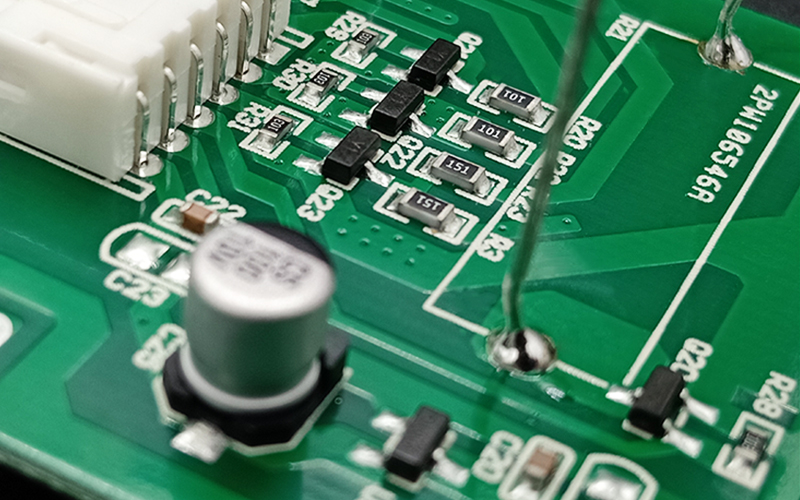
新闻资讯banner
Cleaning technology of SMT surface assembly plate after welding
- Categories:News
- Author:
- Origin:
- Time of issue:2020-09-23
- Views:0
(Summary description)When it comes to SMT surface cleaning process, it is generally organic solvent cleaning or ultrasonic technology cleaning. Because of the high cleaning efficiency, it is widely used in SMT chip processing. Here are the differences between the two
Organic solvent cleaning: organic solvent is used for cleaning and rinsing. After cleaning, the organic solvent on the surface of the workpiece volatilizes rapidly without drying process. The cleaning mechanism is mainly dissolution. This method is suitable for cleaning water sensitive PCB and poor sealing of components.
Ultrasonic cleaning: ultrasonic technology can clean the pollutants at the bottom of components, between components and small gaps. It is suitable for post welding cleaning of SMT with high density, narrow spacing and serious pollution of surface assembly board. Because ultrasonic vibration can produce a large impact force, and has a certain ability to penetrate the components, it can penetrate the layers of the packaging material to enter the internal of the device, and damage the internal connection of the IC. It is generally not recommended for military products. Here is an introduction to the principle of ultrasonic cleaning
Under the action of ultrasonic wave, the cleaning agent forms pore structure and has diffusion effect. The cavity structure can produce a strong impact force, which can clean up the pollutants attached to the surface; ultrasonic vibration can make the liquid particles in the cleaning agent diffuse and accelerate the speed of the cleaning agent dissolving pollutants. In addition, the number of holes, the size of holes and the vibration force of cleaning agent are related to the vibration power and frequency of piezoelectric vibrator. The higher the density and size of the cavity, the higher the cleaning efficiency.
Finally, the selection conditions of cleaning agent are introduced
1. It has good wettability, so that the pollutants on the surface of SMT can be fully wetted and dissolved.
2. moderate capillary effect, small viscosity, can penetrate into the gap of components of the circuit board to be washed, and it is easy to discharge.
3. High density can slow down the volatilization of solvent.
4. High boiling point is favorable for vapor condensation. The cleaning agent with high boiling point has good safety, and the cleaning efficiency can be improved through continuous heating.
5. Solubility. Solubility is also known as kauranyl butanol value (KB value), which is the characteristic parameter of solvent for dissolving pollutants. The higher the KB value is, the stronger the ability of dissolving organic pollutants is.
6. Less corrosive. After cleaning, the characters and marks on the surface of components and printed circuit board can be kept clear.
7. Good safety, non-toxic and harmless, not flammable and explosive.
8. Low cost and less environmental pollution.
Cleaning technology of SMT surface assembly plate after welding
(Summary description)When it comes to SMT surface cleaning process, it is generally organic solvent cleaning or ultrasonic technology cleaning. Because of the high cleaning efficiency, it is widely used in SMT chip processing. Here are the differences between the two
Organic solvent cleaning: organic solvent is used for cleaning and rinsing. After cleaning, the organic solvent on the surface of the workpiece volatilizes rapidly without drying process. The cleaning mechanism is mainly dissolution. This method is suitable for cleaning water sensitive PCB and poor sealing of components.
Ultrasonic cleaning: ultrasonic technology can clean the pollutants at the bottom of components, between components and small gaps. It is suitable for post welding cleaning of SMT with high density, narrow spacing and serious pollution of surface assembly board. Because ultrasonic vibration can produce a large impact force, and has a certain ability to penetrate the components, it can penetrate the layers of the packaging material to enter the internal of the device, and damage the internal connection of the IC. It is generally not recommended for military products. Here is an introduction to the principle of ultrasonic cleaning
Under the action of ultrasonic wave, the cleaning agent forms pore structure and has diffusion effect. The cavity structure can produce a strong impact force, which can clean up the pollutants attached to the surface; ultrasonic vibration can make the liquid particles in the cleaning agent diffuse and accelerate the speed of the cleaning agent dissolving pollutants. In addition, the number of holes, the size of holes and the vibration force of cleaning agent are related to the vibration power and frequency of piezoelectric vibrator. The higher the density and size of the cavity, the higher the cleaning efficiency.
Finally, the selection conditions of cleaning agent are introduced
1. It has good wettability, so that the pollutants on the surface of SMT can be fully wetted and dissolved.
2. moderate capillary effect, small viscosity, can penetrate into the gap of components of the circuit board to be washed, and it is easy to discharge.
3. High density can slow down the volatilization of solvent.
4. High boiling point is favorable for vapor condensation. The cleaning agent with high boiling point has good safety, and the cleaning efficiency can be improved through continuous heating.
5. Solubility. Solubility is also known as kauranyl butanol value (KB value), which is the characteristic parameter of solvent for dissolving pollutants. The higher the KB value is, the stronger the ability of dissolving organic pollutants is.
6. Less corrosive. After cleaning, the characters and marks on the surface of components and printed circuit board can be kept clear.
7. Good safety, non-toxic and harmless, not flammable and explosive.
8. Low cost and less environmental pollution.
- Categories:News
- Author:
- Origin:
- Time of issue:2020-09-23
- Views:0
When it comes to SMT surface cleaning process, it is generally organic solvent cleaning or ultrasonic technology cleaning. Because of the high cleaning efficiency, it is widely used in SMT chip processing. Here are the differences between the two
Organic solvent cleaning: organic solvent is used for cleaning and rinsing. After cleaning, the organic solvent on the surface of the workpiece volatilizes rapidly without drying process. The cleaning mechanism is mainly dissolution. This method is suitable for cleaning water sensitive PCB and poor sealing of components.
Ultrasonic cleaning: ultrasonic technology can clean the pollutants at the bottom of components, between components and small gaps. It is suitable for post welding cleaning of SMT with high density, narrow spacing and serious pollution of surface assembly board. Because ultrasonic vibration can produce a large impact force, and has a certain ability to penetrate the components, it can penetrate the layers of the packaging material to enter the internal of the device, and damage the internal connection of the IC. It is generally not recommended for military products. Here is an introduction to the principle of ultrasonic cleaning

Under the action of ultrasonic wave, the cleaning agent forms pore structure and has diffusion effect. The cavity structure can produce a strong impact force, which can clean up the pollutants attached to the surface; ultrasonic vibration can make the liquid particles in the cleaning agent diffuse and accelerate the speed of the cleaning agent dissolving pollutants. In addition, the number of holes, the size of holes and the vibration force of cleaning agent are related to the vibration power and frequency of piezoelectric vibrator. The higher the density and size of the cavity, the higher the cleaning efficiency.
Finally, the selection conditions of cleaning agent are introduced
1. It has good wettability, so that the pollutants on the surface of SMT can be fully wetted and dissolved.
2. moderate capillary effect, small viscosity, can penetrate into the gap of components of the circuit board to be washed, and it is easy to discharge.
3. High density can slow down the volatilization of solvent.
4. High boiling point is favorable for vapor condensation. The cleaning agent with high boiling point has good safety, and the cleaning efficiency can be improved through continuous heating.
5. Solubility. Solubility is also known as kauranyl butanol value (KB value), which is the characteristic parameter of solvent for dissolving pollutants. The higher the KB value is, the stronger the ability of dissolving organic pollutants is.
6. Less corrosive. After cleaning, the characters and marks on the surface of components and printed circuit board can be kept clear.
7. Good safety, non-toxic and harmless, not flammable and explosive.
8. Low cost and less environmental pollution.
Scan the QR code to read on your phone
Copyright©Sanjing Electronic Technology Co., Ltd. All Rights Reserved 粤ICP备09210657号



 400-1668-717
400-1668-717

 Feedback
Feedback 